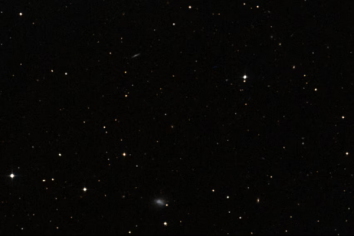
Believe it or not, there's a galaxy at the center of this image. Segue 1 is a very faint dwarf galaxy that contains few stars. New research suggests that at its heart lies an unexpected, gigantic black hole. Image credit: SIMBAD, DSS.
27 October 2025
By Emily Howard
Small and unassuming, Segue 1 is a nearby dwarf galaxy containing only a handful of stars – too few to provide the gravity needed to keep itself from scattering into space. Like other dwarf galaxies, it was long believed that gravity from a mysterious substance called dark matter was the main binding force.
However, new research from The University of Texas at Austin and The University of Texas at San Antonio upends this assumption – challenging astronomers’ understanding of dwarf galaxies. Instead of dark matter, a giant black hole at the heart of Segue 1 provides the needed glue, keeping stars tethered with its gravitational pull.
"Our work may revolutionize the modeling of dwarf galaxies or star clusters to include supermassive black holes instead of just dark matter halos," said Nathaniel Lujan, a graduate student at UTSA who led the research.
The discovery, recently published in The Astrophysical Journal Letters, is the culmination of an astronomy course held jointly by UT Austin and UTSA. Co-taught by astrophysicists Karl Gebhardt (UT Austin) and Richard Anantua (UTSA), the class gave students an opportunity to use advanced modeling technologies and techniques to study gravity’s effects in galaxies.
“We designed this course to foster collaboration between our two universities,” said Gebhardt. “Initially, the project was to model the gravitational dynamics inside Segue 1. That it resulted in a significant discovery is a real testament to the talent of these students and their determined, hard work.”
The students used supercomputers at UT Austin’s Texas Advanced Computing Center to create hundreds of thousands of complex models. Each charted the expected paths of Segue 1’s stars based on the presence of a black hole, its size, the abundance of dark matter, and other hypothetical factors - all in search of a model that closely matched the stars’ real movements as observed by W.M. Keck Observatory.
"Nate came into his first astronomy elective with a great work ethic and a penchant for learning new methodologies," said Anantua. "Both were needed for this project, which combined a steep computational learning curve with a theoretical grasp of strong gravity in the vicinity of supermassive black holes."
The students started by identifying stars under the gravitational influence of Segue 1. Located only 75,000 light-years away, Segue 1 is a very close neighbor of the Milky Way. As such, the far more gravitationally powerful Milky Way is actively drawing stars into itself. This process is called “tidal stripping.” The stripped stars would be spread across Segue 1, with the galaxy’s outer edges dominated by those migrating out. By measuring the population of stars on the outskirts and subtracting that from the central region, they filtered out the stars under the Milky Way’s influence.
Next, the team charted the speed and direction of the remaining stars. It soon became clear that stars toward the center were traveling in quick, tight circles – the tell-tale sign of a black hole. Models with a high proportion of dark matter, or both dark matter and a black hole matched poorly.
Adding to the excitement of finding the black hole was its tremendous size. At an estimated 450,000 times the mass of our Sun, it is roughly 10 times the mass of all the stars in Segue 1 combined. In most galaxies, the mass of a central black hole doesn’t exceed that of the stars.
“There is a strong relation between the mass of the black hole and the mass of the host galaxy. The black hole in Segue 1 is significantly larger than what is expected,” explained Gebhardt. “If this large mass ratio is common among dwarf galaxies, we will have to rewrite how these systems evolve.”
One possible explanation for Segue 1’s development is that it used to be a larger galaxy with far more stars. However, over time the Milky Way may have stolen most of its stars, leaving just a few behind.
Another possibility is that Segue 1 is similar to a newly discovered class of galaxies called Little Red Dots, which appear to have developed with huge black holes and very few stars. Located in the most distant reaches of the universe, these early galaxies are difficult to study. With Segue 1, astronomers may now have a nearby object that allows them to observe some of the processes underway in Little Red Dots.
However this tiny galaxy evolved, Segue 1 is proving an intriguing challenge to current assumptions about dwarf galaxies. Just goes to show that big surprises can come in small packages.
Additional study co-authors include UT Austin’s Owen Chase, Maya Debski, Claire Finley, Om Gupta, Alex Lawson, Zorayda Martinez, Connor Painter, and Yonatan Sklansky and UTSA’s Loraine Gomez, Izabella Marron, and Hayley West. Research was supported by the Simons Foundation.

Believe it or not, there's a galaxy at the center of this image. Segue 1 is a very faint dwarf galaxy that contains few stars. New research suggests that at its heart lies an unexpected, gigantic black hole. Image credit: SIMBAD, DSS.